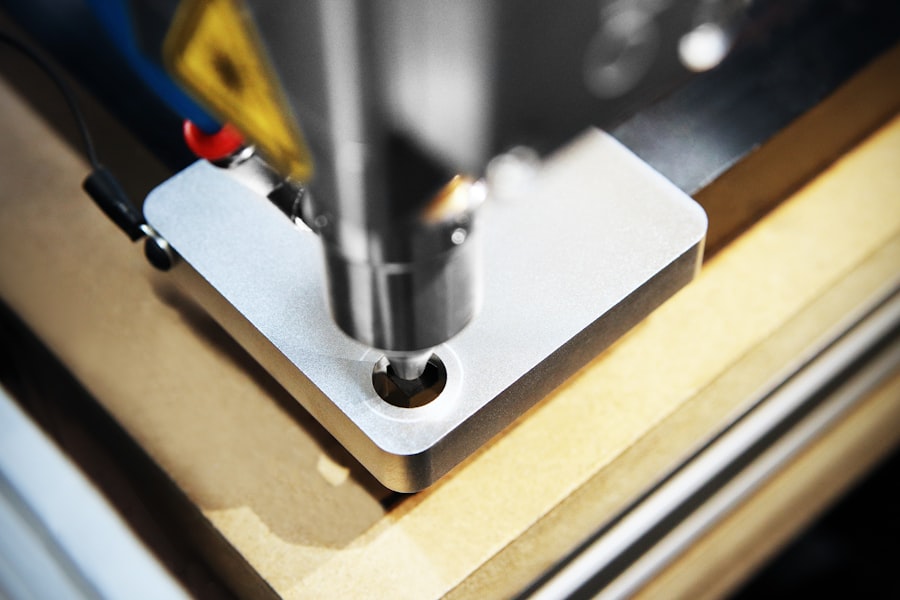Alexandrite laser technology has emerged as a prominent tool in the field of dermatology and cosmetic procedures. This type of laser is named after the Alexandrite gemstone, which is known for its unique ability to change color depending on the light. The Alexandrite laser operates at a wavelength of 755 nanometers, making it particularly effective for various skin types and conditions.
It is primarily used for hair removal, but its applications extend to treating pigmented lesions, vascular lesions, and even tattoo removal. As you explore the world of laser treatments, you may find that the Alexandrite laser stands out due to its efficiency and speed. The laser emits a beam of light that is absorbed by the melanin in the hair follicles, leading to their destruction without damaging the surrounding skin.
This precision makes it a popular choice among both practitioners and patients seeking effective solutions for unwanted hair and skin imperfections. Understanding what Alexandrite laser is can help you make informed decisions about your skincare and cosmetic options.
Key Takeaways
- Alexandrite laser is a type of laser used for various skin treatments, including hair removal and pigmentation correction.
- The laser works by emitting a specific wavelength of light that targets melanin in the skin, effectively destroying hair follicles or pigmented cells.
- The benefits of Alexandrite laser treatment include fast and effective hair removal, as well as improvement in skin tone and texture.
- Alexandrite laser is versatile and can be used on different skin types and for various cosmetic concerns, making it a popular choice for many patients.
- When compared to other laser treatments, Alexandrite laser is known for its precision, speed, and minimal discomfort during the procedure.
How Does Alexandrite Laser Work?
The mechanism behind the Alexandrite laser is rooted in the principles of selective photothermolysis. When the laser light is directed at the skin, it penetrates the epidermis and targets the melanin in hair follicles or pigmented lesions. The energy from the laser is absorbed by the melanin, which converts it into heat.
This heat then destroys the targeted cells while leaving the surrounding tissue unharmed. The precision of this process is what makes Alexandrite lasers particularly effective for hair removal and skin rejuvenation. During a typical treatment session, you can expect a sensation similar to a rubber band snapping against your skin as the laser pulses are delivered.
The treatment is relatively quick, often taking only a few minutes for small areas and longer for larger ones.
Understanding how the Alexandrite laser works can help alleviate any concerns you may have about the treatment process and its effectiveness.
The Benefits of Alexandrite Laser Treatment
One of the most significant advantages of Alexandrite laser treatment is its speed and efficiency. The large spot size of the Alexandrite laser allows for quicker treatment times compared to other lasers, making it an ideal choice for those with busy schedules. You can often complete a session in a fraction of the time it would take with other methods, allowing you to return to your daily activities with minimal disruption.
In addition to its speed, Alexandrite laser treatment is known for its effectiveness on a wide range of skin types, particularly lighter skin tones. The high absorption rate of melanin means that it can effectively target dark hair while minimizing damage to surrounding skin. This makes it a preferred option for individuals seeking long-lasting hair removal solutions or treatments for pigmented lesions.
The results can be impressive, often leading to smoother skin and a more even complexion.
The Versatility of Alexandrite Laser
| Aspect | Metric |
|---|---|
| Wavelength | 755 nm |
| Applications | Hair removal, pigmented lesions, vascular lesions |
| Skin Types | I-VI |
| Pulse Duration | 0.5 ms – 50 ms |
| Spot Size | 2 mm – 18 mm |
The versatility of Alexandrite lasers extends beyond hair removal; they are also effective in treating various skin conditions. For instance, they can be used to address issues such as sun damage, age spots, and freckles by targeting excess melanin in the skin. This capability makes them an excellent choice for individuals looking to improve their overall skin tone and texture.
Moreover, Alexandrite lasers are also utilized in vascular treatments, such as reducing the appearance of spider veins and rosacea. By targeting hemoglobin in blood vessels, these lasers can effectively diminish redness and improve skin clarity. This multifaceted approach allows you to address multiple skin concerns in one treatment session, making it a convenient option for those seeking comprehensive skincare solutions.
When comparing Alexandrite lasers to other types of laser treatments, several key differences emerge. For instance, while Nd:YAG lasers are often used for deeper tissue penetration and are effective on darker skin tones, they may not provide the same level of precision for superficial pigmentation issues as Alexandrite lasers do.
The choice between these different laser types often depends on your specific skin type and treatment goals. If you have lighter skin and are primarily focused on hair removal or treating pigmented lesions, the Alexandrite laser may be your best option due to its efficiency and effectiveness. Understanding these differences can empower you to make an informed decision about which treatment aligns best with your needs.
Who is a Good Candidate for Alexandrite Laser?
Determining whether you are a good candidate for Alexandrite laser treatment involves several factors, including your skin type, hair color, and overall health. Generally, individuals with lighter skin tones and dark hair tend to see the best results from this type of laser treatment due to the contrast between the melanin in their hair and their skin. However, advancements in technology have made it possible for some practitioners to use Alexandrite lasers on a broader range of skin types.
Before undergoing treatment, it’s essential to consult with a qualified professional who can assess your individual circumstances. They will evaluate your medical history, current medications, and any previous skin treatments you may have undergone. This thorough assessment ensures that you receive personalized recommendations tailored to your unique needs and goals.
The Safety and Side Effects of Alexandrite Laser

Safety is a paramount concern when considering any cosmetic procedure, including Alexandrite laser treatments. Generally regarded as safe when performed by qualified professionals, this type of laser treatment has been extensively studied and used in clinical settings for years. However, like any medical procedure, there are potential side effects that you should be aware of.
Common side effects may include temporary redness, swelling, or mild discomfort in the treated area. These effects typically subside within a few hours to a few days post-treatment. In rare cases, more severe side effects such as blistering or changes in pigmentation may occur, particularly if the procedure is not performed correctly or if aftercare instructions are not followed diligently.
Being informed about these potential risks can help you prepare adequately and set realistic expectations for your treatment journey.
Finding a Qualified Alexandrite Laser Provider
Choosing a qualified provider for your Alexandrite laser treatment is crucial to ensuring both safety and effectiveness. Start by researching practitioners who specialize in laser treatments and have experience specifically with Alexandrite technology. Look for credentials such as board certification in dermatology or cosmetic surgery, as well as any additional training in laser procedures.
Reading reviews and testimonials from previous patients can also provide valuable insights into a provider’s skill level and patient care approach. During your initial consultation, don’t hesitate to ask questions about their experience with Alexandrite lasers, the technology they use, and their approach to safety protocols. A reputable provider will be transparent about their qualifications and will take the time to address any concerns you may have.
In conclusion, understanding Alexandrite laser technology can empower you to make informed decisions about your skincare options. From its unique mechanism of action to its versatility in treating various conditions, this advanced technology offers numerous benefits for those seeking effective solutions for hair removal and skin rejuvenation. By carefully considering your candidacy and choosing a qualified provider, you can embark on your journey toward smoother skin with confidence.
If you are interested in learning more about the benefits of laser hair removal, you may want to check out this article on home fashion. This article discusses how laser hair removal can be a convenient and effective way to achieve smooth, hair-free skin. It also highlights the different options available for customizing your laser hair removal treatment, which you can read more about in this article on customizing interests. Additionally, if you are looking for tips on how to maintain your fashion-forward look after laser hair removal, be sure to read this article on fashion home.
FAQs
What is an alexandrite laser?
An alexandrite laser is a type of laser that emits a specific wavelength of light (755 nm) and is commonly used for hair removal and the treatment of pigmented lesions, such as age spots and freckles.
How does an alexandrite laser work?
The alexandrite laser works by targeting the melanin (pigment) in the hair follicles or skin lesions. The laser energy is absorbed by the melanin, which heats up and destroys the targeted cells, leading to hair removal or the fading of pigmented lesions.
What are the benefits of using an alexandrite laser for hair removal?
Some of the benefits of using an alexandrite laser for hair removal include its ability to treat large areas of the body quickly, its effectiveness on a wide range of skin types, and its relatively low risk of side effects when used by a trained professional.
Are there any potential side effects of alexandrite laser treatment?
While alexandrite laser treatment is generally safe when performed by a qualified practitioner, potential side effects may include temporary redness, swelling, and discomfort at the treatment site. In rare cases, there may be changes in skin pigmentation or scarring.
How many sessions are typically needed for alexandrite laser hair removal?
The number of sessions needed for alexandrite laser hair removal varies depending on factors such as the individual’s hair color, skin type, and the area being treated. On average, multiple sessions spaced several weeks apart are required to achieve optimal results.






